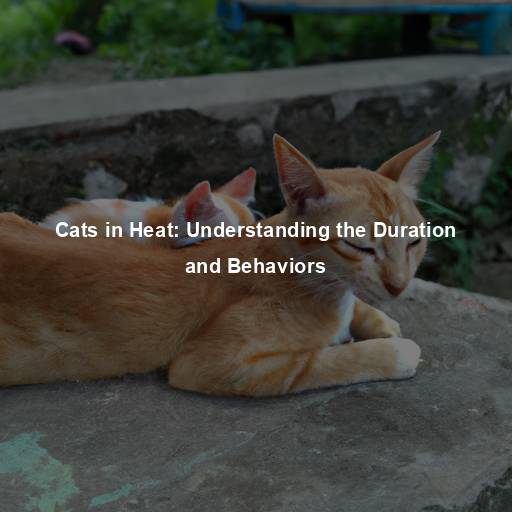Why Do Cats Jump So High?
Last Updated on October 22, 2023 by Evan
Contents
- 1 Unraveling the Mysteries of Feline Leaping Abilities
- 1.1 The Nature of the Cat
- 1.2 Anatomical Marvels
- 1.3 The Physics of a Cat’s Jump
- 1.4 Evolutionary Advantages
- 1.5 The Joy of Jumping
- 1.6 Conservation of Energy
- 1.7 The Role of Muscles and Tendons
- 1.8 Takeoff and Landing Techniques
- 1.9 Adaptations for High Jumping
- 1.10 A Fascinating Display of Feline Agility
- 1.11 Ancestral Traits
- 1.12 Hunting Strategies
- 1.13 Escape and Defense
- 1.14 Territorial Marking and Communication
- 1.15 The Role of Natural Selection
- 1.16 The Wonders of Feline Athleticism
- 1.17 Appreciating the Feline Leap
- 2 FAQs – Why do Cats Jump So High
- 2.1 Why do cats have such impressive jumping abilities?
- 2.2 What is the purpose of a cat’s high jumping ability?
- 2.3 Are all cat breeds equally skilled at jumping?
- 2.4 How high can cats actually jump?
- 2.5 Can cats’ jumping abilities be improved?
- 2.6 Do cats jump high for fun, or is there a specific reason behind it?
Unraveling the Mysteries of Feline Leaping Abilities
Cats are known for their incredible agility and acrobatic skills. From effortlessly scaling tall trees to gracefully pouncing on their prey, these feline creatures possess an extraordinary ability to jump to astounding heights. But have you ever wondered why cats can jump so high? In this article, we will delve into the fascinating world of feline athleticism, exploring the anatomical and evolutionary factors that contribute to their impressive leaping prowess.
The Nature of the Cat
Prepare to be astounded as we delve into the enigmatic world of feline jumps. But before we unravel the mechanics that propel these mesmerizing creatures into mid-air, let us first bask in the ethereal allure of cats themselves. These enigmatic beings possess an insatiable curiosity and a grace that defies comprehension. Honed by millennia of evolution, their innate hunting prowess and extraordinary physical prowess have ensured their survival across various ecosystems.
Anatomical Marvels
Delving into the captivating realm of feline agility, we unravel the enigmatic secrets behind a cat’s awe-inspiring jumping prowess. Prepare to be bewitched as we unfurl a tapestry of wondrous anatomical wonders that empower these graceful creatures to conquer great heights with an air of mystique. Journey with us as we navigate the labyrinthine corridors of their unique physique, peeking into the intricate mechanisms that orchestrate their astonishing acrobatic feats. Join us on this enthralling odyssey, where gravity-defying leaps meet perplexing elegance, and the enigma of feline anatomy takes center stage.
Cats are truly fascinating creatures, and one of their most intriguing features is their muscular hind legs. These limbs pack quite the punch, propelling them into the air with remarkable force. With well-developed muscles like the quadriceps and gastrocnemius, felines can unleash bursts of energy that leave us in awe of their incredible jumping abilities.
- Flexible Spines: The flexibility of a cat’s spine plays a crucial role in their jumping prowess. Unlike humans, cats have a highly flexible backbone consisting of numerous small vertebrae. This allows them to arch their backs and extend their hind legs, maximizing their jumping potential.
Discover the mesmerizing secrets behind our feline friends’ seemingly effortless acrobatics! Cats possess an extraordinary level of joint flexibility, specifically in their hips and knees, allowing for unparalleled agility. Their remarkable range of motion empowers them to execute breathtaking leaps with a remarkable combination of accuracy and elegance. Embark on a captivating exploration into the enigmatic world of supple joints, unraveling the hidden wonders that enable cats to transcend the boundaries of graceful mobility.
When it comes to feline athleticism, we often marvel at their hind legs’ impressive jumping power. But, my friends, let’s delve into a realm of unparalleled fascination – the oft-overlooked realm of those mighty front legs and robust shoulder muscles. These unsung heroes play a vital role in launching our favorite feline warriors into the air and ensuring a graceful touchdown. So, let’s celebrate the magnificence of both ends of the spectrum – the hind legs and the front legs – for a complete understanding of feline athleticism.
The Physics of a Cat’s Jump
To truly understand why cats can jump so high, we must turn to the laws of physics. Every jump a cat makes is a testament to the principles of energy and momentum. Here’s a breakdown of the physics behind a cat’s leap:
-
Conservation of Energy: When a cat prepares to jump, it crouches down, coiling its muscles like a tightly wound spring. This crouch position stores potential energy within the cat’s muscles. As the cat releases this stored energy, it is converted into kinetic energy, propelling the cat into the air.
-
The Role of Momentum: To achieve maximum height and distance, cats utilize the principle of momentum. By swiftly extending their hind legs and pushing against the ground with great force, cats generate momentum that propels them upward. The quick extension of the hind legs, combined with the flexible spine, allows cats to convert their horizontal momentum into vertical motion.
When it comes to defying gravity, cats may seem like natural-born acrobats. However, even these agile felines can’t escape the overpowering force of gravity. As they gracefully leap towards the skies, their upward motion gradually succumbs to the relentless pull of gravity, bringing them back down to earth. But there’s another twist in this physics equation – the pesky interference of air resistance.
Evolutionary Advantages
Jumping high enables cats to escape from predators, explore their surroundings, and capture agile prey with precision. This evolutionary adaptation has bestowed upon them a remarkable ability to gracefully navigate their environment, showcasing their innate grace and agility. As they leap through the air, their powerful hind legs propel them with astonishing speed and grace, leaving spectators in awe and perplexity.
- Hunting Efficiency: Cats are natural-born hunters. Their exceptional leaping abilities enable them to ambush and capture prey with precision, giving them a significant advantage in the hunt. By leaping high, cats can reach elevated vantage points, increasing their chances of spotting potential prey and launching successful attacks.
When faced with peril or hot pursuit, our feline companions possess a remarkable knack for survival. Through their graceful mastery of agility and a powerful vertical leap, cats defy danger with an air of ease. Scaling towering trees or propelling themselves onto elevated perches, these enigmatic creatures elude their relentless pursuers, gracefully claiming safety for themselves while perplexing those left behind.
Cats have an intriguing way of asserting their authority—by gracefully leaping onto elevated surfaces. This seemingly simple act actually serves a much higher purpose. From their designated thrones, our feline friends engage in a strategic form of territory marking, surveying their surroundings with unparalleled confidence and sending a clear message to other cats: “This is my domain”. It’s a fascinating display of power and communication, where cats utilize their acrobatic skills to leave an indelible mark on their territories.
The Joy of Jumping
Beyond the practical benefits, jumping is an integral part of a cat’s nature and behavior. Cats take delight in showcasing their athletic prowess, often engaging in playful jumps and leaps. Whether it’s chasing after a toy or gracefully leaping from one perch to another, cats find joy in their ability to defy gravity and explore their surroundings from new heights.
Conservation of Energy
Within the graceful movements of a feline lies an enigmatic secret – the art of conservation, where energy takes center stage. As a cat seamlessly crouches in contemplation, it embarks on a journey of inner potential, storing the very essence of power within its sleek frame. With a mesmerizing release of muscles, the cat unleashes a storm of kinetic energy, propelling itself into the ethereal realm of the air. The deeper the well of energy from which a cat draws, the loftier its jump shall be, defying the ordinary and embracing the extraordinary.
The Role of Muscles and Tendons
While a cat’s hind legs play a significant role in generating the force needed for a jump, the muscles and tendons throughout its body work in unison to achieve the desired result. The powerful muscles in a cat’s legs, such as the quadriceps, gastrocnemius, and hamstrings, contract rapidly, providing the necessary force for propulsion. Additionally, the tendons in a cat’s legs act as elastic springs, storing and releasing energy efficiently, contributing to the cat’s impressive jumping ability.
Takeoff and Landing Techniques
In addition to the energy transfer and muscle power, a cat’s takeoff and landing techniques contribute to its ability to jump to great heights. When a cat jumps, it typically pushes off the ground with its hind legs, propelling itself upward. The swift extension of the hind legs allows the cat to convert its horizontal momentum into vertical motion, propelling it higher into the air.
Have you ever watched a cat gracefully land on its feet with seemingly magical precision? It’s truly a perplexing display of feline agility and body control. With remarkable flexibility, these enigmatic creatures can effortlessly twist and adjust their bodies mid-air, ensuring a smooth touchdown. Their ability to minimize the impact upon landing is nothing short of awe-inspiring, leaving us burst with wonder at the marvels of nature.
Adaptations for High Jumping
Throughout the ages, felines have undergone a mesmerizing transformation, acquiring an astonishing set of skills that propel them to astounding heights. These awe-inspiring abilities, forged through the relentless forces of evolution, showcase the sheer brilliance of nature’s selection process. From nimble paws that grant them unparalleled agility to keen senses honed for the art of hunting, cats have developed a remarkable repertoire of adaptations that leave us in a perpetual state of wonder. Among these extraordinary marvels, the power of their vertical leap stands as a testament to their unsurpassed resilience and unparalleled prowess.
Enhanced Musculoskeletal Structure
Cats have a lightweight yet robust musculoskeletal structure that contributes to their agility and jumping prowess. Their bones are lightweight and filled with air sacs, reducing overall weight while maintaining strength. This anatomical advantage allows cats to leap with ease and agility.
Sharp Claws and Powerful Paws
A cat’s claws and paws are essential tools for maintaining balance and gaining traction during a jump. Cats can extend and retract their claws, using them to grip surfaces and propel themselves upward. The pads on their paws provide extra grip, allowing them to generate more force and stability during takeoff and landing.
Exceptional Balance and Coordination
When it comes to feline acrobatics, cats are the true masters of balance and grace. Their innate ability to execute flawless jumps is a testament to their finely tuned coordination and keen sense of spatial awareness. Thanks to their advanced vestibular system tucked away in their inner ears, cats can make lightning-fast adjustments in mid-air, landing with pinpoint precision and greatly reducing their chances of getting hurt. It’s truly baffling how effortlessly these creatures navigate the world, defying gravity with every leap they take.
Agile Spines and Limber Bodies
Have you ever been awestruck by the astounding jumps of our feline friends? It’s truly mind-boggling how their spines can seamlessly twist and turn, thanks to the intricate arrangement of their vertebrae. This extraordinary flexibility, coupled with their remarkable muscular prowess, allows cats to effortlessly arch their backs and propel themselves into the air, reaching incredible heights and distances that leave us mere mortals in utter amazement.
A Fascinating Display of Feline Agility
In the animal kingdom, few creatures can match the grace and athleticism of a jumping cat. Whether it’s a domesticated house cat or a mighty wild feline, their ability to jump to impressive heights is a testament to their remarkable anatomical adaptations, the laws of physics, and their instinctual behaviors. So, the next time you witness a cat effortlessly soaring through the air, take a moment to appreciate the marvel of nature’s engineering that allows these creatures to defy gravity and captivate us with their remarkable leaps. ## Exploring the Evolutionary Origins
The extraordinary jumping abilities of cats can be traced back to their evolutionary history. Throughout their journey, cats have developed and honed their jumping skills to adapt to various environments and enhance their chances of survival.
Ancestral Traits
The feline family, Felidae, is a captivating assortment of species, each with its own unique charm. From lithe climbers to nimble leapers, these marvelous creatures have inherited a legacy of acrobatic excellence from their ancestors. A long line of agile and adept hunters has bestowed upon today’s cats the remarkable ability to navigate their surroundings with unparalleled grace and precision. It is truly fascinating to witness the evolution of jumping prowess in these captivating felines.
Hunting Strategies
The awe-inspiring skill of cats to effortlessly soar to great heights imparts them with an undeniable advantage when it comes to their intricate hunting techniques. Instinctively wired as nimble predators, these graceful felines harness their unparalleled leaping prowess to meticulously strategize and execute their prey-capturing endeavors. By propelling themselves to soaring heights, cats gain access to elevated lookout points like towering tree branches and rugged rock formations, granting them an unparalleled opportunity to keenly survey their surroundings and meticulously devise their hunting tactics. From these elevated perches, they unleash their unmatched agility and precision, stealthily pouncing on unsuspecting victims with unfathomable swiftness and unerring accuracy.
Escape and Defense
Apart from hunting, jumping serves as a vital defense mechanism for cats. When faced with a potential threat or pursued by a predator, cats rely on their agility and vertical leap to escape. By swiftly ascending trees or leaping onto higher surfaces, cats can put distance between themselves and their pursuer, making it harder for predators to reach them. The ability to evade danger through their superior jumping skills has played a crucial role in the survival of cats throughout the ages.
Territorial Marking and Communication
It’s fascinating how cats strategically use their acrobatic talents to carve out their own little kingdoms. By scaling fences and perches, they become the kings and queens of their domains, overseeing their surroundings with watchful eyes. These high-rise habitats also serve as a secret language, enabling cats to broadcast their authority to fellow felines through visual signals and territorial marks. It’s a captivating glimpse into the enigmatic world of our feline friends.
The Role of Natural Selection
The mesmerizing artistry of feline acrobatics transcends mere chance, as the enigmatic dance of natural selection weaves its intricate tapestry. A cat’s majestic leap through the ages is a testament to the captivating forces of evolution. Through an enigmatic collaboration between anatomy and behavior, a symphony of advantage unfolds. Mighty hind legs, a supple spine, and a mystifying equilibrium converge, bestowing upon our feline companions the profound prowess to outmaneuver prey, safeguard their domains, and triumph over perilous encounters.
The Wonders of Feline Athleticism
There is a certain mystique surrounding the awe-inspiring leaps of our feline friends that leaves us both baffled and entranced. Their seemingly boundless athleticism defies logic and challenges our understanding of the natural world. With muscles honed to perfection and a spine that bends with unearthly flexibility, cats can reach heights that make our jaws drop and our minds race with questions. As they effortlessly soar through the air, we can’t help but wonder at the evolutionary marvel that has crafted such graceful and powerful creatures.
Appreciating the Feline Leap
Have you ever stopped to truly marvel at the awe-inspiring agility of cats? Their ability to effortlessly leap to great heights is nothing short of miraculous. It’s a complex dance between their intricate anatomy, the laws of physics, and the remarkable adaptations that have evolved over time. These acrobatic displays not only serve practical purposes but also reveal the captivating beauty and indomitable spirit of these majestic creatures.
FAQs – Why do Cats Jump So High
Why do cats have such impressive jumping abilities?
Cats are known for their impressive jumping abilities due to a combination of physical adaptations and instinctual behavior. Firstly, cats have strong hind legs that provide them with excellent propulsion power. Their leg muscles, particularly the calves, are specifically designed for strong bursts of energy, making them adept at launching themselves off the ground. Additionally, cats possess a flexible spine that enables them to extend their bodies while in mid-air, further enhancing their jumping skills.
What is the purpose of a cat’s high jumping ability?
In the wild, felines possess an innate prowess for hunting, and their acrobatic leaps are a secret weapon in their pursuit of survival. With an extraordinary capability to soar to unfathomable heights, these agile creatures effortlessly access raised perches that provide a panoramic view of their surroundings, serving as crucial vantage points for spotting potential prey or detecting lurking dangers. This instinctual behavior embraces their innate instincts, allowing them to navigate treacherous terrains and evade both predators and unforeseen obstacles. Moreover, their unparalleled aptitude for defying gravity also acts as a means of escape from perilous situations or grants them access to otherwise unreachable domains during their exploratory escapades.
Are all cat breeds equally skilled at jumping?
While all cats possess a natural aptitude for jumping, the extent of their skills may vary depending on factors such as age, health, and individual genetics. Generally, the majority of domestic cat breeds have similar jumping abilities, thanks to their shared ancestors with wild cats. However, it is worth noting that some cat breeds may have different body proportions, weight distribution, or physical conditions that can influence their jumping prowess to a certain extent.
How high can cats actually jump?
Cats, those marvelous beings of feline athleticism, possess an astonishing ability to defy gravity with their lithe bodies. It is said that a cat, when primed and ready, can effortlessly surpass its own dimensions in a single, majestic leap. Picture this: a cat measuring a mere two feet, a seemingly unassuming size, can bewilder with a bound of up to twelve feet. However, it must be understood that the furry wonders of the world, with their idiosyncrasies and varied capabilities, may exhibit slight variations in this extraordinary feat.
Can cats’ jumping abilities be improved?
Cats are already exceptional jumpers by nature, but their jumping skills can indeed be enhanced with practice and exercise. Regular physical activity, such as interactive play sessions or providing stimulating toys to encourage jumping, helps cats maintain their agility and strength. Additionally, training routines that involve hurdles or obstacle courses can help cats refine their jumping technique and increase their jumping distance over time. However, it’s crucial to ensure that any training or exercise is done in a safe and supervised environment to prevent the risk of injury to the cat.
Do cats jump high for fun, or is there a specific reason behind it?
Cats, those enchanting creatures that grace our lives with their presence, possess a mysterious allure when it comes to their jumping prowess. It is a captivating sight to witness them effortlessly soar through the air, defying gravity with a grace that leaves us in awe. But what prompts these feline acrobatics? The answer, my dear readers, lies in the intricacies of their complex nature. Beyond the surface level of playful amusement, cats’ penchant for jumping is steeped in a tapestry of motives and purposes. Yes, my friends, it serves as a means of not only staying physically fit but also as a mental stimulation for these cunning creatures. Moreover, it allows them to unveil the depths of their territory, marking it with every elegant leap. And let us not forget the aspect of hierarchy, for jumping becomes a declaration of dominance in the presence of their fellow feline companions. So, dear readers, as we marvel at the ethereal leaps of our feline friends, let us appreciate the elaborate tapestry of their instincts and desires that propel them to new heights, both metaphorically and literally.







